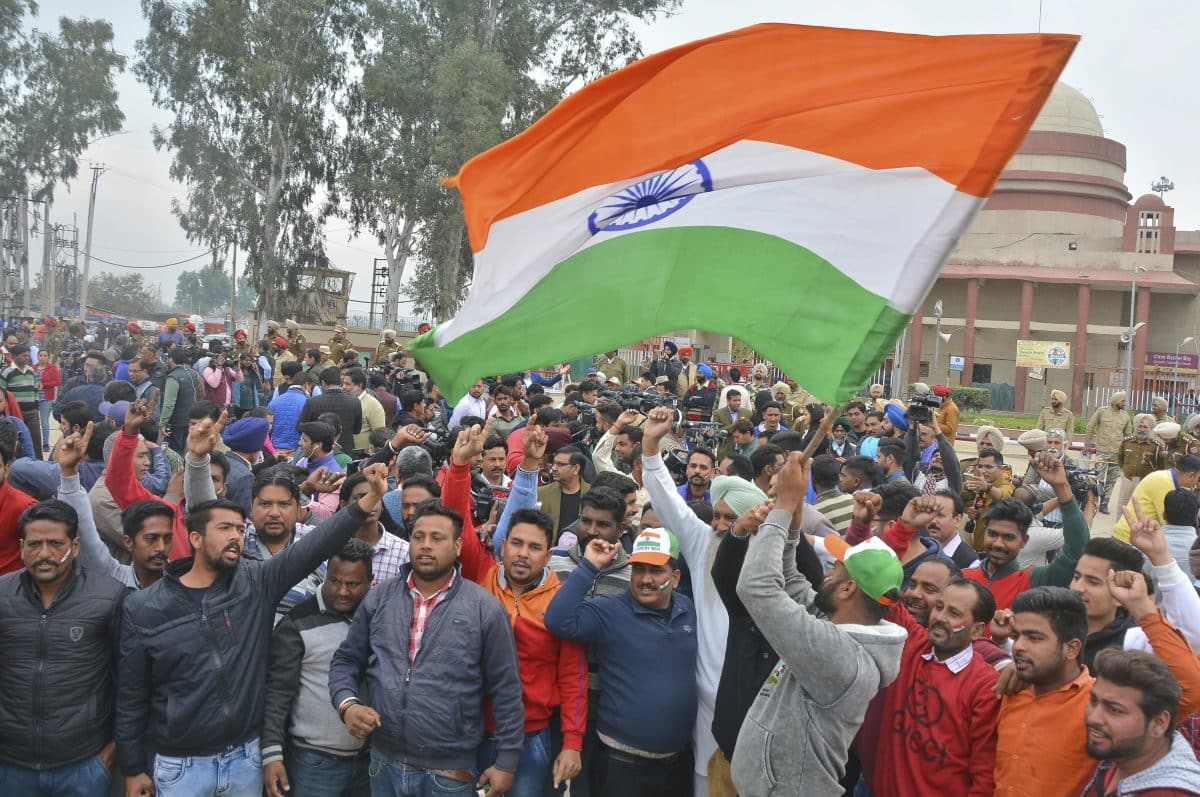A decades-long conflict over Kashmir escalated rapidly last week. Here’s why fights between India and Pakistan matter to the world.

Indians wait to welcome the return of a captured Indian pilot at the India-Pakistan border, 1 March 2019 (AP Photo/Prabhjot Gill)
India and Pakistan have traded artillery and gunfire for decades across the front-line that separates the disputed Himalayan region of Kashmir.
Last week that conflict escalated rapidly when India sent warplanes to strike inside Pakistan for the first time since the two sides fought a full-scale war in 1971. A day later, on Wednesday, Pakistan struck back with both sides claiming to have shot down the other’s jets.
How did the two nations get into this position and why does it matter to the rest of the world?
Q. What caused the latest flare-up?
The immediate cause came on February 14 when a suicide-bomber killed 40 young Indian paramilitary recruits in the Pulwama district of Jammu and Kashmir — the part of Kashmir ruled by India.
The bomber was an Indian Kashmiri, but responsibility for the attack was claimed by Jaish-e-Mohammad (JeM), a Pakistani-based Islamist group that India charges has close ties with Pakistan’s military intelligence agency, the ISI.
The bombing was the deadliest attack in Kashmir and the worst strike by Muslim jihadis in India for more than a decade.
It came on top of another attack by JeM in Kashmir last September, which caused the deaths of 19 Indians. In response to that incident, Indian Prime Minister Narendra Modi ordered special forces over the “Line of Control” that separates Indian and Pakistani Kashmir to carry out what he called “surgical strikes.”
The bombing is part of a layered history.
Modi had Indian commentators baying for revenge after the Pulwama attack, and he ordered jets armed with 1,000 lb (450 kg) bombs to strike what he said was a JeM base in Balakot inside Pakistan. India said it had killed hundreds of militants, while Pakistan claimed the bombs had fallen harmlessly on a forested area.
Pakistan’s military, spooked that Indian jets had got perilously close to the country’s capital without being intercepted, struck back. In the ensuing dogfight, at least one Indian jet was brought down with the pilot being captured after parachuting into Pakistani Kashmir.
Q. Why does this matter to the rest of the world?
The simple answer is that both India and Pakistan have nuclear weapons. Since both sides tested nuclear devices in the 1990s, Kashmir has come to be seen as one of the world’s most dangerous flash points.
Each side has broadly the same number of nuclear warheads and the missiles to deliver them, the Stockholm International Peace Research Institute reported last year. India’s conventional forces are orders of magnitude greater than Pakistan’s, but Islamabad sees its nuclear capability as vital in limiting military adventurism by Delhi.
Neither side wants a full-scale conflict, but political factors raise the danger of miscalculation.
Politics raises the risk of miscalculation.
India’s Modi, whose Bharatiya Janata Party campaigns by whipping up Hindu nationalist fervour, faces an election in April. He has to balance making political capital out of recent events and not letting strident nationalism in the country force him into a corner.
In Pakistan, Prime Minister Imran Khan is a former national cricket captain who won power last year but has relatively little experience in the political cauldron. As always in Pakistan, the country’s powerful military call many of the shots from behind the scenes.
Q. What is at the root of the conflict?
Ever since Muslim Pakistan was carved out of British colonial India at independence in 1947, Kashmir has been at the heart of the conflict between the two countries.
Pakistan was the borne out of the bloody partition of the subcontinent when millions of Muslims fled east and west to what were then East and West Pakistan. Millions of Hindus fled in the other direction, and hundreds of thousands died on both sides.
At the time of partition, Kashmir was a princely state ruled by a Hindu monarch despite the region being overwhelmingly Muslim. Kashmir was expected to go to Pakistan, but Hari Singh hastily agreed to be a part of India in return for military assistance against invading Pakistani tribesmen.
Many wars have been fought over Kashmir.
India and Pakistan fought a second war over Kashmir in 1965 and a third in 1971 when India supported an uprising in East Pakistan and the independence of what became Bangladesh.
A ceasefire line in Kashmir was agreed to in 1972 that came to be known as the Line of Control. To the south and east lay the Indian-ruled Vale of Kashmir. North and west lay Pakistan-ruled Azad, or free Kashmir. And a third section high up in the Himalayas was taken by China.
The beautiful Vale of Kashmir used to be a mecca for tourists and Indian honeymooners drawn to the capital Srinagar’s Dal Lake with its many wooden houseboats acting as floating hotels.
Both India and Pakistan are accused of carrying out atrocities.
That all ended in the late 1980s when anger at heavy-handed rule from Delhi sparked a Muslim separatist insurgency. Some fought to join Pakistan, others for independence, while India poured troops and paramilitary forces into the region.
India has always accused Pakistan’s military of arming and training the insurgents. Pakistan officially denies that, saying it offers only political support. But, in the past, I have seen, first-hand, boxes of new assault rifles being unloaded from an army truck and handed over to militants in Muzaffarabad, the capital of Azad Kashmir.
Both sides are accused of carrying out atrocities inside Indian Kashmir in a 30-year conflict that has killed tens of thousands. Jaish-e-Mohammad is blamed for being behind some of the worst. India says the JeM and its leader, Masood Azhar, operate freely inside Pakistan and demand action from the government in Islamabad to stop militants launching operations from its soil.
Q. How do the two sides de-escalate the conflict?
Efforts to cool tensions are already showing some results. Pakistan freed the captured Indian pilot, Wing Commander Abhinandan Varthaman, at a frontier post with India late last week.
World powers have urged both sides to step back from the brink. Russian President Vladimir Putin spoke to the leaders of both countries, according to a Kremlin statement. U.S. Secretary of State Mike Pompeo also urged restraint when he spoke to the foreign ministers of the two nations, a sentiment echoed by both the European Union and China.
Pakistan closed its airspace to all flights after India attacked but said it expected commercial flights to resume fully.
Tensions remain high along the line of control, however, and it would only take another big attack by militants inside Indian Kashmir to send the temperature soaring once more.
(For another story on the importance of Kashmir and on relations between India and Pakistan, click here.)
QUESTIONS TO CONSIDER:
- When did India gain independence from Britain? Why was Pakistan established as a separate country?
- Where is Kashmir? Why have India and Pakistan fought over it for decades?
- Why does this localized conflict matter to the rest of the world?
 Malcolm Davidson worked for four decades as a journalist in Europe, Asia and Australasia. He served as correspondent with Reuters in India, Pakistan, Afghanistan and the Philippines, and reported widely from other parts of Asia. He also worked in Brussels and most recently was the London-based editor of Reuters’s Front Page multimedia news service.
Malcolm Davidson worked for four decades as a journalist in Europe, Asia and Australasia. He served as correspondent with Reuters in India, Pakistan, Afghanistan and the Philippines, and reported widely from other parts of Asia. He also worked in Brussels and most recently was the London-based editor of Reuters’s Front Page multimedia news service.
